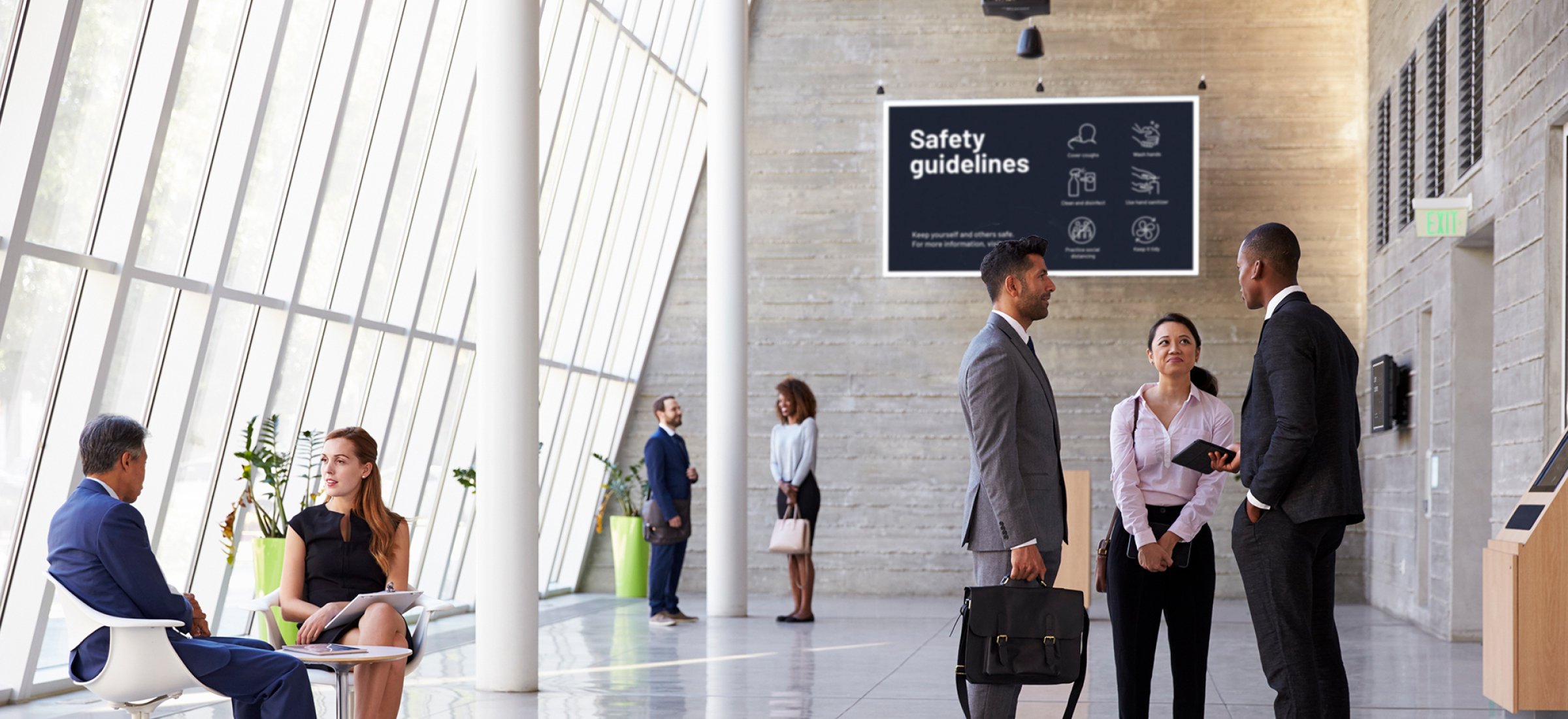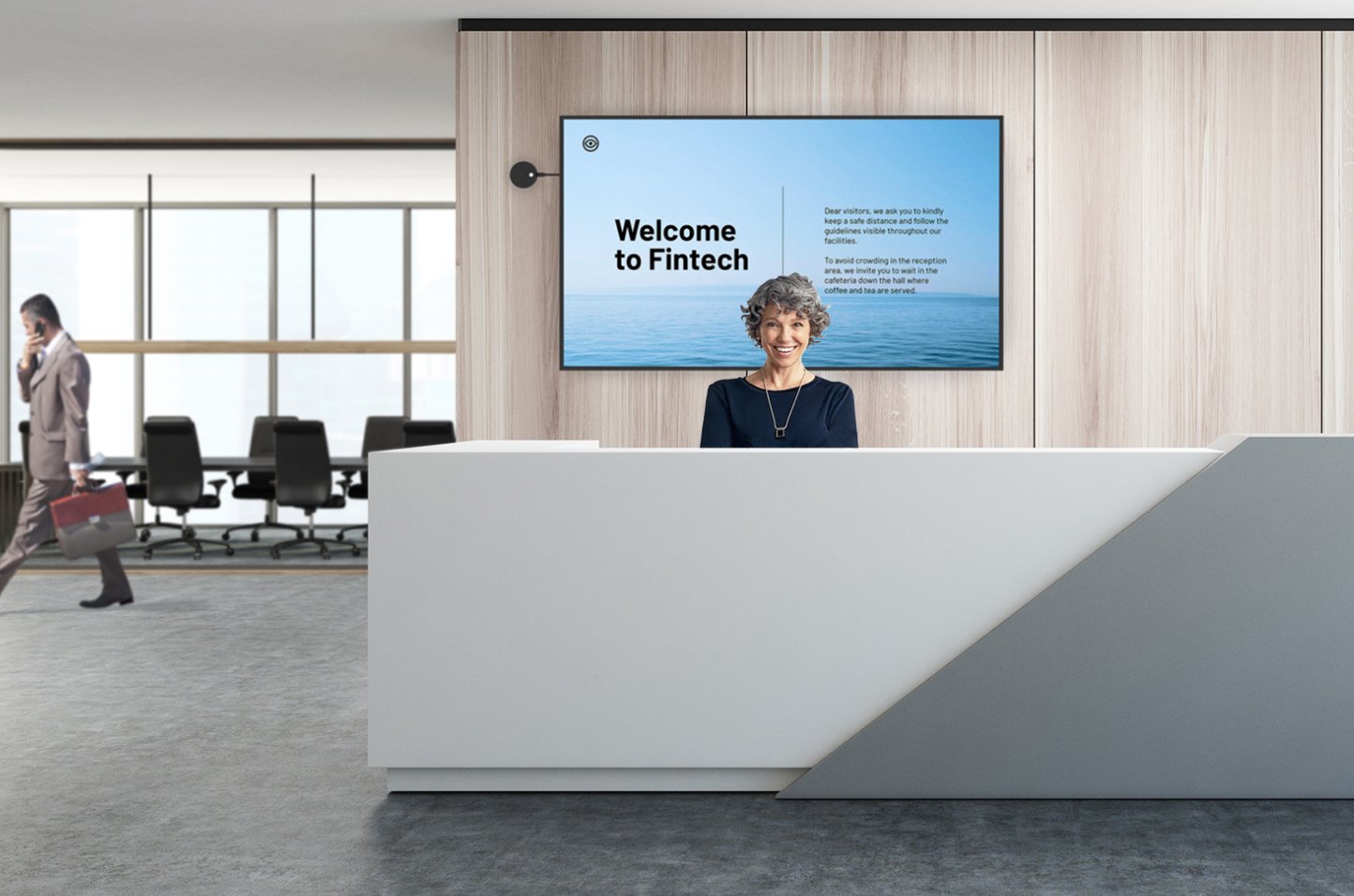This installment of our post-lockdown series looks at how digital signage can help keep people safe and informed as they pass through the hallways, reception areas, and cafeterias at work.

This installment of our post-lockdown series looks at how digital signage can help keep people safe and informed as they pass through the hallways, reception areas, and cafeterias at work.
Last week we offered examples of how digital signage can help promote safety and awareness in meeting rooms. This week we’re looking at the types of messaging and imagery that are relevant to digital signage in shared spaces.
Using digital signage with solutions like Airtame Cloud is both efficient and hygienic, as remote access to every screen allows for fast, bulk updates while avoiding physical contact with remote controls and touchscreens. It’s also cost-effective considering how most organizations already own many screens that are not being used to their full potential.
Open, communal spaces around work are often the epicenter of activity, where people wait for meetings to start or socialize with colleagues. High-traffic spaces like the lobby or the office cafeteria need special care to keep everyone safe as they gradually return to work. If we don’t rethink our usual habits and plan accordingly, shared spaces can quickly become disorganized and overcrowded. This increases the likelihood of contagion; something everyone wants to avoid. On that thought, let’s look at some practical ways to get them ready for reopening.

In a reception area or similar space that’s open to the public, a website can be an educational asset to showcase. A website might summarize what the company is doing for its employees and/or the community during a difficult socio-economic period.
A website can also be used to welcome back employees and create an inviting atmosphere for guests. For example, a welcome screen may invite visitors to enjoy tea or coffee in the cafeteria in order to avoid crowding in the reception area. Such an approach kills two birds with one stone: it ensures safety while showing hospitality.
Depending on the design, a website can fade in and out between showing a written message and calming imagery, or a combination of both. Using an online slide show can also be used in a similar way, with the option to tweak images and messages remotely.
While physical safety is the top priority, signage can also be used to send motivating messages that reinforce the importance of mental health. Don’t hesitate to use websites or slides to promote available resources such as psychosocial support covered by employee insurance.

Having room overviews scattered around hallways can help attendees get to the right room in time so they can hopefully start and finish meetings on time. As employees return to work, there will be new limits on the number of people allowed in a given area at a set time. This means that punctuality will be more important than ever if we are to 1) avoid throwing other events off schedule (such as lunch shifts—see next example), and 2) avoid crowding in hallways as people wait for their colleagues to clear out of the room. A third reason applies regardless of a pandemic: punctuality shows respect for your own and others’ time.
In addition to supporting punctuality, room overviews can also help workplaces that plan to repurpose some meeting rooms for temporary office space. Some organizations have adopted this strategy to accommodate larger distances between people who normally sit in open-plan offices. A room overview can help communicate this by displaying rooms whose agendas specify “blocked for desk work”.
As in the case of the room overview, digital signage in cafeterias can help enforce safe distances via punctuality. Having employees take their lunch break in shifts is a logical way to minimize contagion if anyone at work is sick and doesn’t know it. For both meeting room bookings and lunch shifts, the displayed times can demonstrate caution by including a 5-minute buffer between events. Some people will be eager to catch up with their work friends when they first get back, so having a buffer can help accommodate a bit of social loitering.
In any space where food is served, a key topic for signage to convey is hygiene. Messages can be targeted at diners as well as anyone handling meal preparation (e.g. catering staff). In such settings, digital signage can remind people to wash their hands, use hand sanitizer, clear away their own dishes and trash, wear gloves, hair nets, etc.
Playlists take digital signage a step beyond the above examples, letting you combine different types of apps (websites, room overviews, etc.) to have different content playing on a loop. Playlists are most relevant to shared spaces, as it’s in these areas that people are most likely to gaze at a screen for an extended period of time (like how people stare at ads on the subway to avoid unwanted eye contact with strangers).
Granted, almost anyone can occupy themselves with a smartphone while waiting around or taking a break. But if a digital signage screen does grab the attention of a passerby, it’s a great opportunity to communicate anything from safety guidelines to employee benefits and company values. Playlists can be the medium for your message, with the option to specify how long certain content should play on the screen before the next thing pops up.
The need is as great as ever to implement efficient tools to communicate and collaborate across locations. Whether you work in communications or IT, human resources, or upper management, digital signage is relevant to your safety. You can have a say in what’s on display.
Airtame Cloud Plus fills this need with a central, remote management solution that enables you to send the right message in the right place at the right time. There is no limit to the number of screens you can access or the number of colleagues you can invite to the cloud. It’s even possible to assign different permission levels according to user roles.
And don’t forget that any Airtame-equipped screen also offers wireless screen sharing, keeping presenters safe without the need to share any cables or dongles that may be contaminated.
Contact us to learn more.
Stay safe.